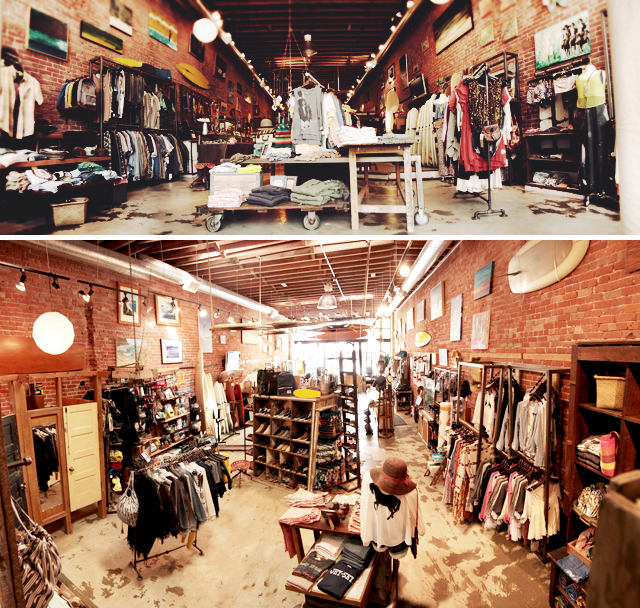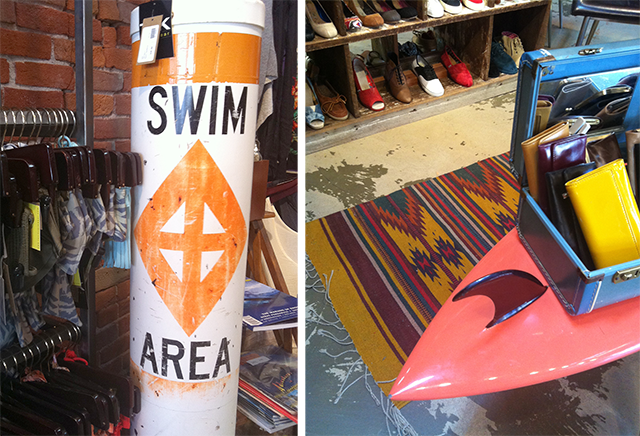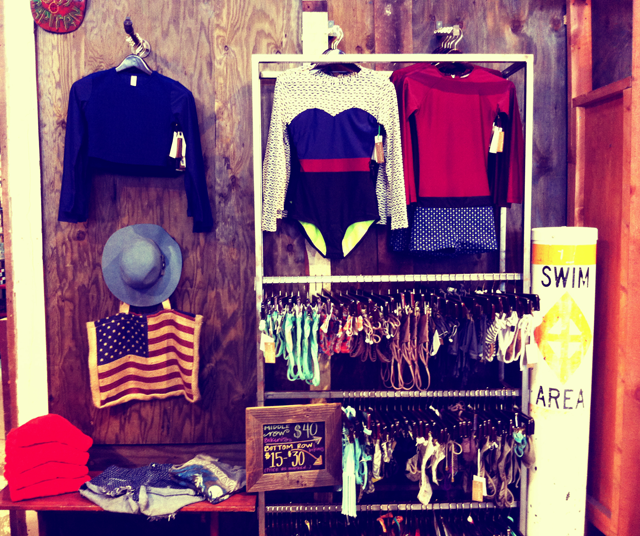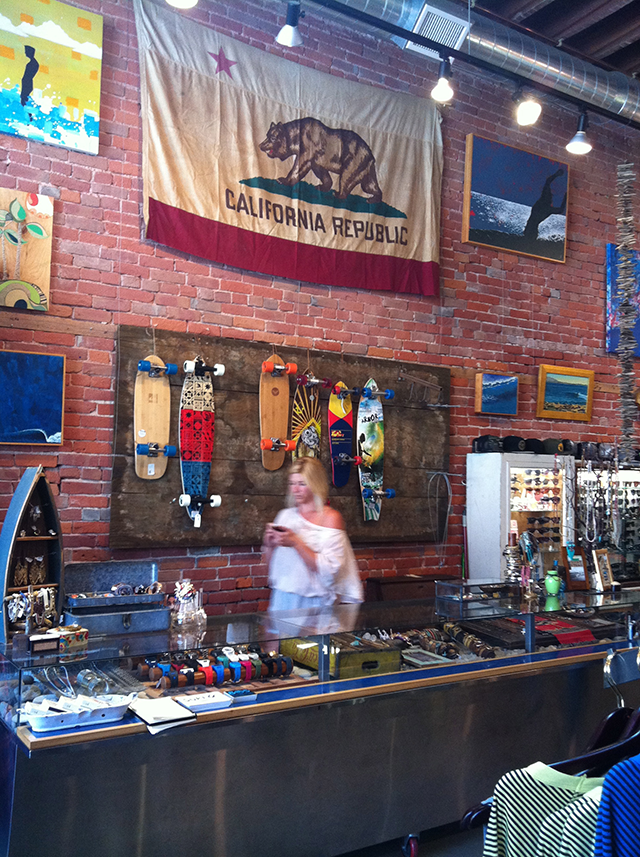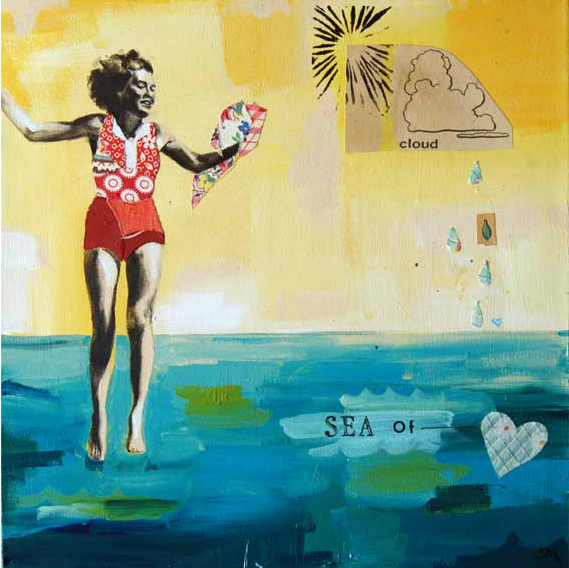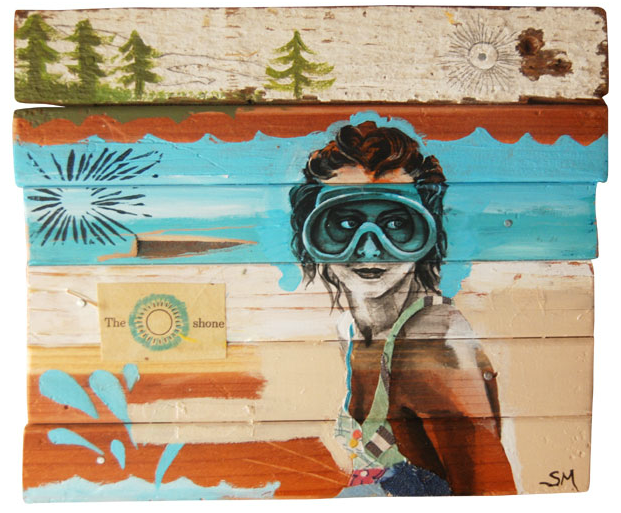 |
| Mele paints outside. Photo by Luki O'Keefe. |
We discuss with Mele Saili about why going through the process of creating art and surfing is therapeutic and fulfilling.
The thing with painting, drawing, and surfing is that to do it, you're completely involved in that moment. There is no room for the stressful thoughts of what has happened or what is going to happen. It challenges you to be present, just like meditation.
I've noticed that when I feel upset, angry, or sad is when I produce my greatest work — not to say I can't create when I'm happy but — I like to harness that emotional tension to fuel my performance. Afterwards that pressure is released and transformed into something positive.
How does being in the flow of painting or drawing feel like being in the flow of surfing?
The flow is similar in the way that it's an organic expression of your personality. You can try to surf or paint in someone else's style but when you stop thinking and let your natural movements take hold, it is more raw and unique because no matter what no one can do it exactly as you can.
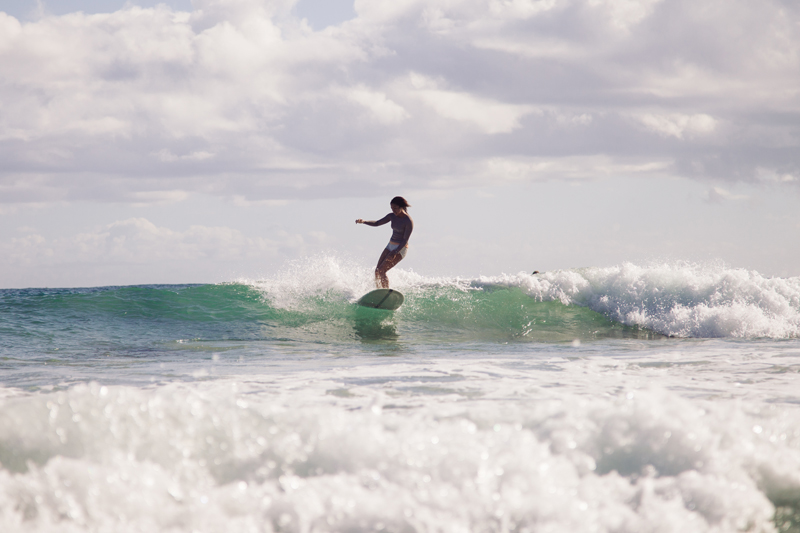 |
| Mele in the Swami's in Cocodot. Photo by Roisin. |
 |
| Mele in the Swami's in Cocodot. Photo by Roisin. |
 |
| Mele Saili. Photo by Luki O'Keefe. |
 |
| Mele's art. Photo by Luki O'Keefe. |
What do you gain personally from creating art and surfing? Does it matter to you what happens to the artwork after you’ve made it?
I do sell my work and have shows here and there but I don't care if I sell anything.
Some pieces I love and some pieces I hate, but I do it more for the process. The images are sort of a diary of things I'm interested in at that moment.
When I look at older work, the emotions I had when I was creating them come back to me and I can remember what was going on in my life when I made it —sounds strange.
Everyone does it differently but when I draw I start with one idea and expand off of that, I don't have an end plan. Along the way I make mistakes that I work into the picture and ultimately the mistakes become the best part of the overall piece. Just like surfing — you move to the way the wave forms and make it up as you go- it's spontaneous.
Kids draw and craft constantly — they're always creating — but that transition into adulthood brings a serious tone to life therefore, creating for yourself isn't encouraged.
I think everyone should have a way to express themselves despite what other people think. That's how culture evolves.
 |
| Mele painting. Photo by Luki O'Keefe. |
 |
| Photo by Luki O'Keefe. |
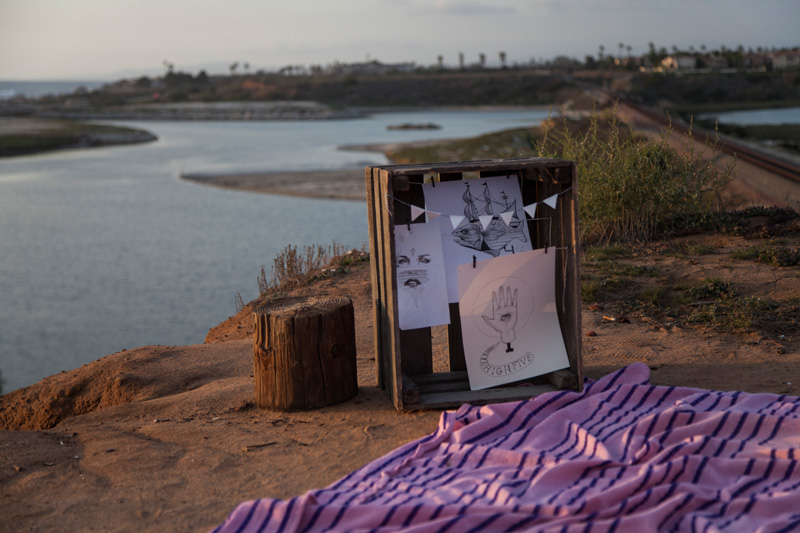 |
| Photo by Luki O'Keefe. |
 |
| Photo by Luki O'Keefe. |
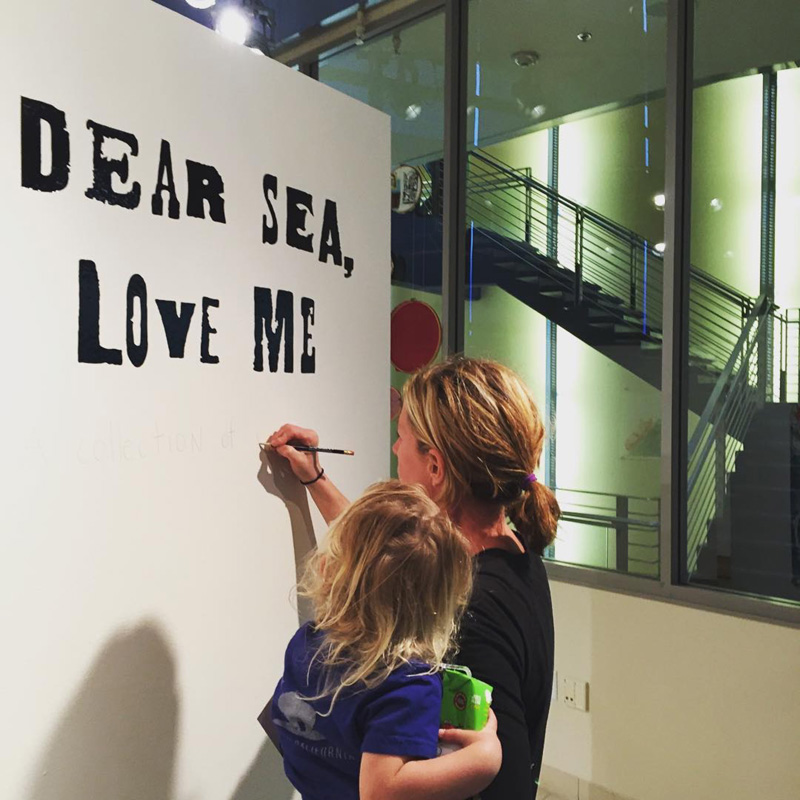
 |
| A look at Julie Goldstein's work displayed at CSU San Marcos. |
I always appreciate when I receive feedback, especially when viewers challenge my concepts and vision. It inspires me and helps me to reflect on my concepts.
When you see all your work together, how have you seen yourself evolve as an artist and person?
It is interesting, the stories have changed and developed over the years, but the core content and inspiration is the same. I have always felt very strongly about coupling my passions for the sea with stories that have evolved over time about women, relationships and my personal experiences. I try to keep my work semi-autobiographic and personal. My ideas keep evolving as my own life shifts and changes over time.
How does each piece represent a turning point?
Each piece is a considered a chapter in a book. They represent different parts of my life. Women who I know personally and women who are pioneers that relate to me on different levels. The sea, surfing and my connections to nature are always a strong part of the work.
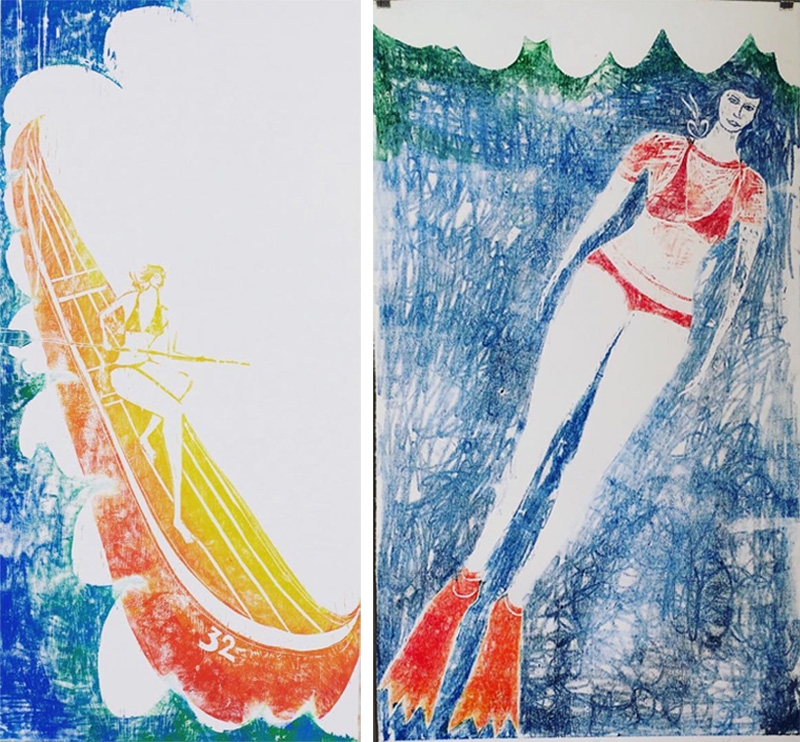 |
| Two of Julie Goldstein's prints. Photos courtesy of the artist. |
Why is it important to continually grow, evolve, and through all that, what about yourself is always the same?
It is important to pay attention to life and how we evolve over time. I feel that as my personal life evolves so does my work. They are closely related. However, my core content, values and beliefs stay the same. How I portray this story will always evolve as the meaning and who I am stays the same.
I wish that I were given more guidance at a young age on how to connect to the art world, galleries and museums. I think that most challenging part of being an artist is finding consistent work and galleries to exhibit in. Having a cohesive body of work is very important. My advice to young artists is keep working, producing art and do not fear showing your work and receiving feedback. Believe in your goals and passions and you will persevere.
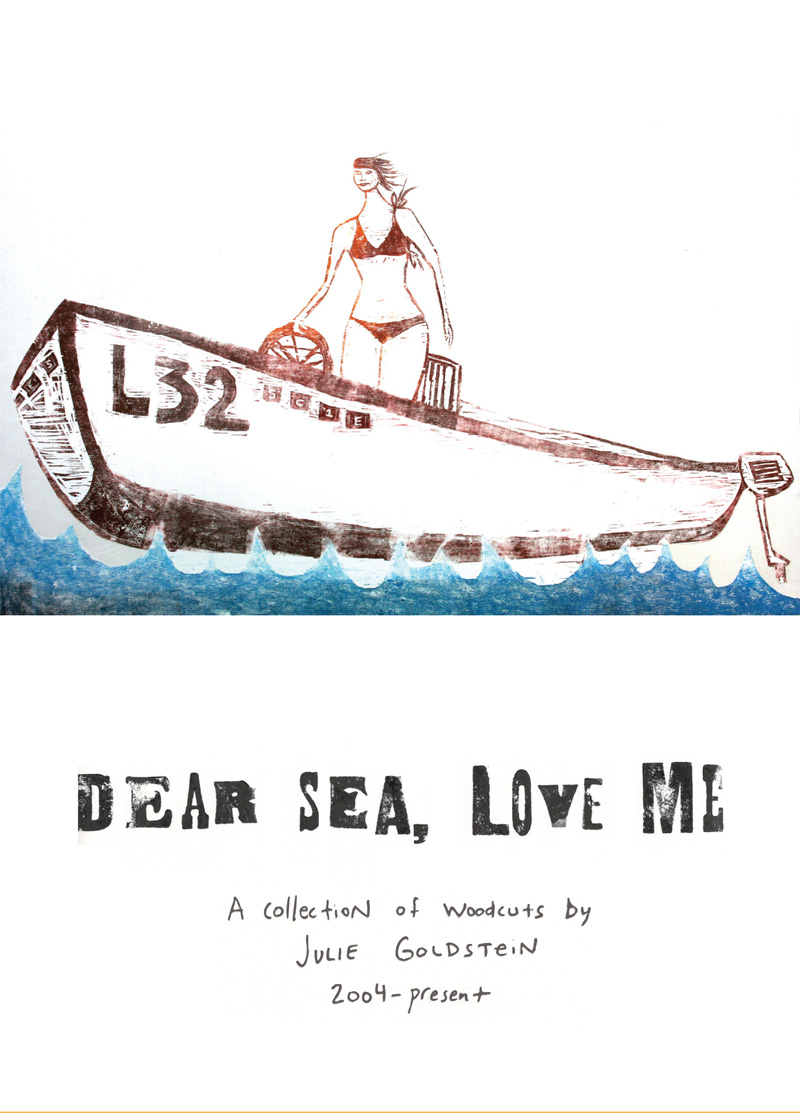 |
| Current exhibition. |

Most people's memories flash back in the brilliant realism of photographs, but if you’re illustrator Natalia Resmini, the figures in your dreams dance in watery pigments and brushstroke lines.
]]>
From left, Natalia Resmini Lola Mignot and Karina Rozunko dance at the CasaLove. Illustration by Natalia Resmini. Photo by Luki O'Keefe.
Most people's memories flash back in the brilliant realism of photographs, but if you’re illustrator Natalia Resmini, the figures in your dreams dance in watery pigments and brushstroke lines.
The Italian Seeababe shared with us her sketchbook of drawings compiled on a visit to Sayulita, Mexico earlier this year for the MexiLogFest. Melding the photographs by fellow traveler Luki O’Keefe and local shooter Ed Fladung, Natalia’s paintings add an emotional soundtrack layer to the freeze-framed instants.
“My idea was to collect the best pictures of the holiday, and write a story using the drawings as a “Fil Rouge” (common thread). The relationship between the drawings and the picture comes from the memory and the shape. I would call it “a sensation game.
I would like to thank Ed Fladung, Luki O’Keefe, Alessandro Ponzanelli and the Seeababes for their collaboration and unique view."
You’ll never look at vacation slideshows the same way again.
 |
From left, Karina Rozunko, Lola Mignot and Natalia Resmini at CasaLove. Illustrations by Natalia Resmini. Photo by Luki O'Keefe. |
 |
From left, Hallie Rohr, Lola Mignot and Justine Mauvin. Illustration by Natalia Resmini. Photo by Luki O'Keefe. |
 |
Unofficial mayor of Sayulita, Israel Preciado. Illustration by Natalia Resmini. Photo by Ed Fladung. |
 |
Luki O'Keefe hands the camera to a friend. Illustration by Natalia Resmini. |
 |
Lola Mignot paddles out. Illustration by Natalia Resmini. Photo by Luki O'Keefe. |
 |
Nathan Strom. Illustration by Natalia Resmini. Photo by Luki O'Keefe. |
 |
Sebastiano Concas hangs ten. Illustration by Natalia Resmini. Photo by Alessandro Ponzanelli. |

|
Seeababes sisterhood. Illustration by Natalia Resmini. Photo by Luki O'Keefe. |
 |
Drinking memories. Photo of artist, Natalia Resmini by Ed Fladung. |
MORE ART
]]>
Juggling art studio work, surfing play time and raising a toddler, Julie Goldstein is a brilliant multi-tasker. Read on to find out what drives Julie's artistic storytelling.
]]>
 |
| Artist Julie Goldstein carving wood in her studio. Photo by Sarah Lee. |
 |
| Julie Goldstein's art prints made from woodblock carvings. "Miss Clara T. Hurst AKA T-BONES with babies" and "Miss Florence B. West AKA FLO with babies." |
My work has always been about women: camaraderie with women, women in history, women that I know and stories that have been passed down to me. My work re-tells these stories and often plays on the alter-ego of women in contrast to the day to day reality of each personality. I often portray women surfing and swimming, the ocean has always been a strong element in my work. Each piece tells a story that I hope instills empowerment and meaning to the "true self."
What are some examples of your artwork series about women?
The "Women and Children on Dirt bike" series [based on observation while traveling through Costa Rica) is about motherhood and how mothers are nurturing yet fearless. This experience made me reflect on our society and how different our culture is compared to others. After watching women in Central America cruising on their dirt bikes sans helmets and shoes, I felt a desire to create a body of work that expresses the strength of these women and how they empowered me. I look at these women as role models and created each woodcut 4 feet x 8 feet to exhibit them life size.
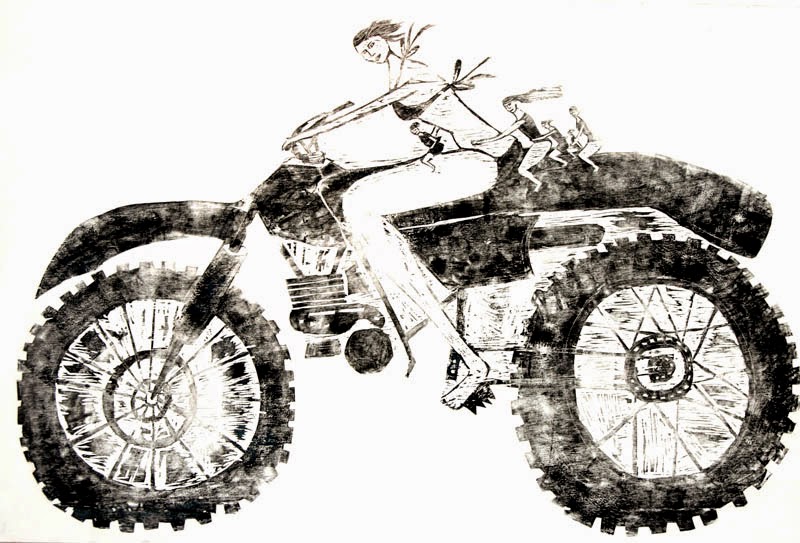 |
| A woodcut print from the "Mother and Children on Dirbikes" series by artist Julie Goldstein. Photo courtesy of Julie Goldstein. |
Your women’s lifesaving league series has women surfing on longboards and holding babies. Was that after you gave birth to your son, Frankie?
 |
| Inside Julie Goldstein's art studio. Photo by Takashi Tomito. |
What’s the story behind Swim With Me, your collaboration project?
My art series, "Swim With Me" was the first body of work that I created after we moved to California from New Jersey, after Pine burned down in 2008. I lost most of my woodcuts and art in that fire and starting over was challenging. This body of work was about starting over, being fearless with my concepts, images and message. I decided I was going to make it about swimming because being in the water is my happy place and it is the place where I reflect and find inspiration. In the swirl pieces, I used a lot of negative space. This was something new for me. I decided to recycle wood remains from the fire and to use them in a new way, a positive way. In front of the swirls, I drew girls swimming, surfing and riding dirt bikes. Are they carrying the swirls with them or leaving them behind? Is it water or is it fire?
I created my brand SWM (Swim with me) this past year. It was inspired by the stories that I tell in my work. SWM is a collaboration brand and allows me the opportunity to work with other designers, artists and brands to make beautiful product and accessories. I chose the name SWM because it represents commraderie, working together and creating together. My first collaboration was with artists at Cal State Long Beach. I worked with natural dyers to create a line of tees, tanks and bags created with organic materials and natural dyes.
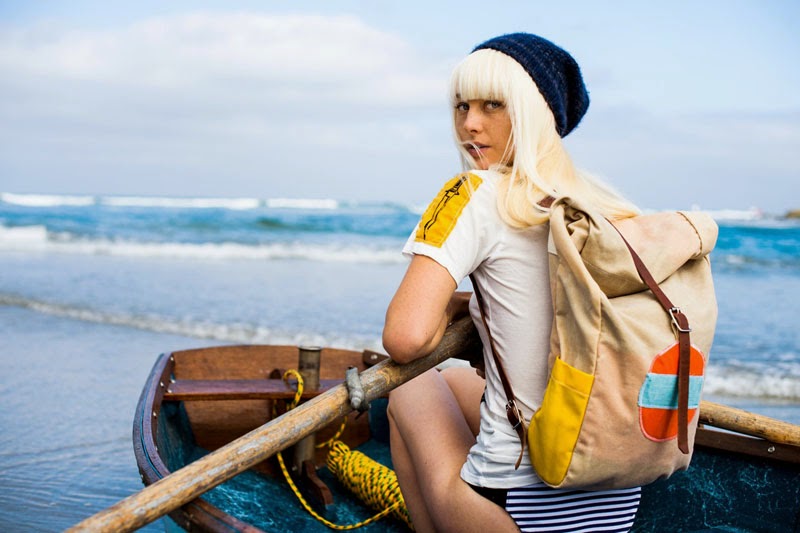 |
| SWM backpack and t-shirt by Julie Goldstein. Photo by Dane Peterson. |
 |
| Julie Goldstein trying on a sample of the Axxe wetsuit collaboration. Photo by Sarah Lee. |
 |
| One of Julie Goldstein's artworks that employs a woodcut print and fabric. Photo courtesy of Julie Goldstein. |
Your first SWM project is clothing and natural dying, how did you come upon natural dying?
Being a mother of a toddler has changed mostly my schedule rather than my process. I still produce and create in the same manner, its just that my blocks of time to work in my studio are limited. I have to give my self more time to complete work and reach deadlines. Some days I research, others I draw, carve or sew, it just depends on the project. Basically, I work when Frankie sleeps, so that can be 1 hour a day or 3 hours a day, it just depends. Finding that sweet balance has been challenging, but we are making it work. Frankie loves to be in the studio with me and soon enough will be making art with me!!
 |
| Julie Goldstein and her son Frankie. Photo by Mark Tesi. |
In what ways has having a child inspired your work?
Having a child has inspired me in many ways. Frankie reminds me of my inner-child and gives me permission to explore, express and PLAY! Watching Frankie and being around children has motivated me in a new way. I also want to be a role-model for Frankie and teach him to be comfortable around materials and the creative process. We are constantly doing and creating in our home.
You say that you’re “an East coaster that lives on the west coast” even though you’ve been here for seven years. What’s the East Coast mentality?
I love the East coast and am proud to say that I am from New Jersey. The East has a different energy; Its fast, its opinionated, its loud and it knows what it wants! The East coast has seasons, which always affected my creativity, color palette and subject matter. We lived on Long Beach Island; it hustled in the summer and was desolate in the winter. The winter months were quiet, cold and helped me to focus on my studio work. I was and still am very inspired by the East coast. My friends and family are all apart of my work, storytelling and memories. As much as I love living on the West coast, I do miss the East.
How do you balance your East coast roots with west coast life now?
Mark and I are both inspired by the East coast mentality, yet love the West coast way of living. I think there has to be a balance and have finally learned where the sweet spot is between work and relaxing. We travel back home (East) quite a bit. My goal is to travel back for the summer months. My very good friend Ann Coen opened up a gallery on Long Beach Island, were I exhibit my work and sell SWM product. I would like to be back East more often to work with my clients and collaborate with artists and designers as well as find inspiration from my roots.
 |
| Julie Goldstein in her art studio. Photo by Takashi Tomito. |
 |
| "Under the Full Moon Winter" artwork by Julie Goldstein. |
What’s the surf culture like in East coast?
Surfing on the East coast is about friendship. We all knew each other and encouraged each other to surf, even on cold, snowy days. Its more intimate and everyone is stoked to be surfing. I remember even on big days, the guys were always rooting for the girls, forcing us to take off on big sets. Back when I was growing up, it was a small group of people that surfed, now it seems like everyone is surfing, including the girls!
Did you surf with any women growing up?
I had three girl friends that surfed with me as a teenager. We all got our first surfboards and wetsuits when we were 11. I will never forget those days. We would get so excited to paddle out, even on rainy, stormy days. When I was in my mid 20's, there was a group of us. These ladies inspired my first body of work titled "Team Riders."
Do you consider yourself a surf artist?
My art has a lot to do with my experiences as a surfer, however I do not pigeonhole myself as a "surf artist." There are many components to my work that tell my story and surfing is a big part of who I am and where I feel my "true self." It is my soul and I am very inspired by my relationship with the sea. The fact that I am a surfer is great because I am naturally nestled into the culture, however my work tells stories, it is semi-autobiographical and portrays many aspects of my life, people and experiences.
 |
| A woodcut print by Julie Goldstein. Photo courtesy of Julie Goldstein. |
How did you feel when you first surfed in Seea?
Wearing my Seea suit is empowering. It's a fashion statement. They are sexy without being revealing. I get so many complements on my Seea suits, I have several and want more!!
What’s next for you Julie?
I have a few collaboration projects happening right now. I just launched a wet suit line with Axxe. I am also working as an artist in resident at Carmel Mountain Preschool. I am creating an art program and studio for 250 children under the age of five. Working with children has been rewarding and inspiring!! This summer I launch a collaboration with the author Corinne Ruff, I am illustrating her book titled "The Sea" and will exhibit the show at The Ann Coen Gallery, as well as exhibiting at Bing and creating a one of kind surfboard that will be up for auction. Lastly, SEEA and I have something up our sleeves!! That collaboration will launch soon, I am very excited to work with the genius Amanda Chinchelli!!
Happy Mother's Day, Julie! Thanks so much for speaking with us and we can't wait to show everyone the new bag collaboration we've been working on together.
Follow along with Julie's SWM project on Instagram at @swmwithme and visit her websites: swm.la and juliegoldstein1.com
MORE ART STORIES:
Joni Sternbach’s photographs use a large-format camera and the nineteenth-century wet-plate collodion process in which she hand-pours the plates and develops on location. Read on for how Sternbach met up with Seeababe Karina Rozunko and why she loves to shoot real photographs.
]]>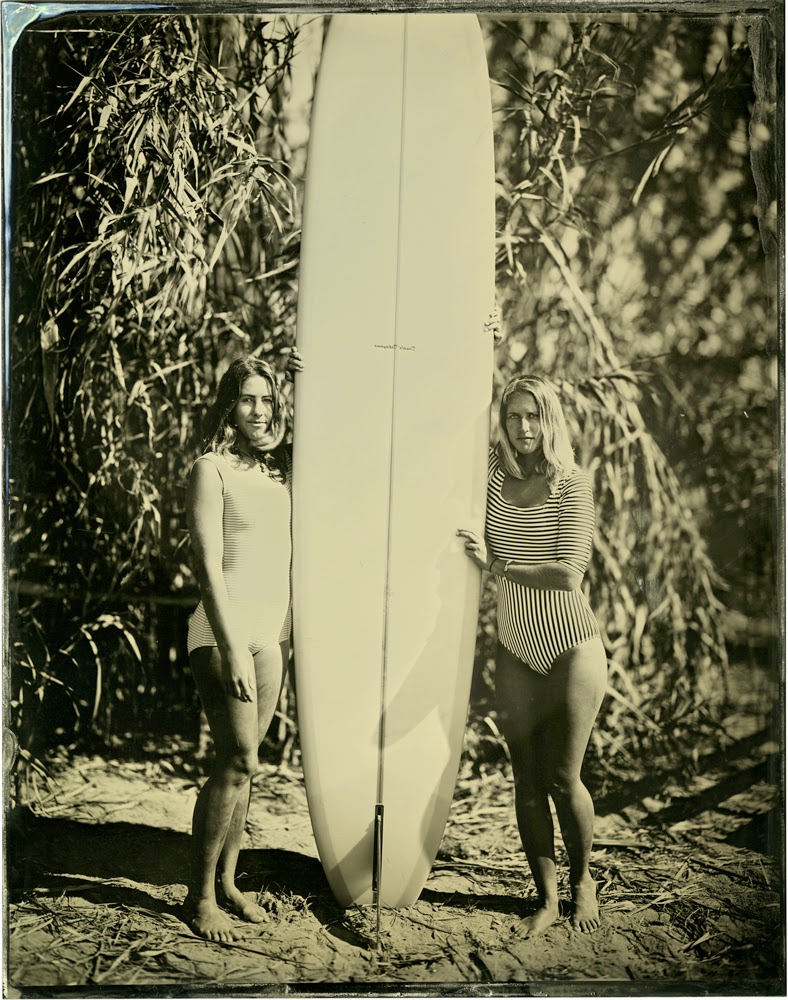 |
| Karina Rozunko wearing the Tofino in Blue Tide and Charlotte Shanahan wearing the Zuma in Black Stripe. Photo by Joni Sternbach. |
At the tap of our camera phones, pixels light up to become images in our hands pretty much anywhere we are and any time we want. It’s easy to forget that taking photos used to be a lot of work. The click of a real button, the sound of film winding, the thoughtful marinating in a bath of chemicals and then hanging to dry. Actually taking the photo? That’s the easiest part says Brooklyn, New York-based photographer Joni Sternbach.
“It's the preparation that takes the most time and scrutiny,” she explained. “Making sure my chemistry is ‘groomed,’ mixed well, aged to perfection (if only it were like a fine wine) all contribute to giving the end result its character.”
Joni Sternbach’s photographs using a large-format camera and the nineteenth-century wet-plate collodion process in which she hand-pours the plates and develops on location are immediately captivating. Her otherworldly tintype portraits of surfers on the shore have been compiled into the art books: “Surfland” published in 2009 and most recently “Surf Site Tintype” published this year.
On one of Sternbach’s trips to the West coast, she met Seeababe Karina Rozunko and her friend Charlotte Shanahan on the beach in Hamburg (wearing Seea surf suits, naturally). The photos that resulted from their encounter took our breath away in the textures of the print, and how authentically vintage they appeared.
We caught up with Sternbach to find out more about why she loves to shoot real photographs and how surfers came to be her subjects.
 |
| From left, Charlotte Shanahan and Karina Rozunko taken in Hamburg. Photo by Joni Sternbach. |
How did the portraits that you took of Karina Rozunko and Charlotte Shanahan at San Onofre come about?
I met Karina through the surfer, Jen Smith. I was headed south to San Diego and San-O was on the way, so we decided to meet there. I made just a couple of plates when 'the ranger' showed up. He took one look at our dark tent and decided we were a big production and that we needed a permit.
I explained that I am an artist, not a commercial venture and that I wasn't hired by a company to make these pictures, but that I do it all on my own. That did not faze him in the least. He watched over us like we were teenagers about to strip naked-and skinny dip illegally in public. It was rather ridiculous. He allowed me to take one film shot… and to be honest, if he hadn't hassled the shit out of us, I might never have made that picture!
We found another spot to shoot at that was quite beautiful, filled with the emptiness of western imagination.
 |
| Karina Rozunko wears the Tofino. Photo by Joni Sternbach. |
Tell us about your career as a photographer. When did you start shooting and discover that you liked photography as your medium of choice?
I first started taking pictures in college. It was a required course at the art school I attended. My first successful picture was a still life of a cheesecake with a slice cut out of it. Not that I'd advise anyone out there to base a career choice on a single image like that, but something about how ordinary the picture was, combined with the black and white chemistry and magic of watching the image develop in the darkroom struck me and stuck with me.
I switched my major from fine arts and made a choice to be a photographer. I studied with people who mostly shot on the street and learned to tell a very personal story by pointing the lens outward. My first body of work was (made over a period of time) on the subway. Back in the ‘70’s, NYC was a tough place and photographing in the subways was illegal. I used a quiet range-finder camera that I wore around my neck under my coat with a preset focus. I guesstimated the image frame based on the wide-angle lens I was using. Raising the camera to my eye drew a very different response from subjects, so I tried to minimize that action.
 |
| Karina Rozunko wears the Tofino. Photo by Joni Sternbach. |
How did you discover this method that you currently use of the wet-collodion process?
I learned the wet-collodion process, which includes the tintype from John Coffer, one midday summer in 1999. John is an unconventional man who lives a 19th century life on a farm in upstate NY. He teaches workshops on the process and hosts a big jamboree on his farm every summer for all the crazy wet-platers out there in the world.
What were your first photos using the medium?
I started shooting near the ocean, where I had been making these close-up, abstract images of the ocean surface, called 'Ocean Details.' Making pictures by the shoreline was a practice I was becoming committed to. The wet-plate medium has very specific sensitivities and insensitivities that make photographing certain subjects challenging, however it reads textures really well, which meant there had to be a strong subject amidst the landscape. I found remnants of civilization and life along the shoreline, so I aptly named my first series "Abandoned." They were haunting ambrotype and tintype images that felt like they could have been taken a hundred years ago.
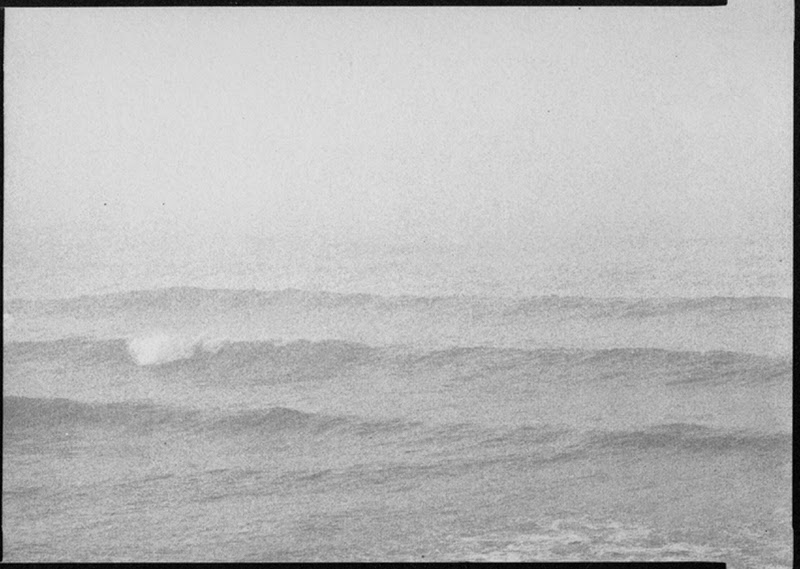 |
| Ocean details by Joni Sternbach. |
 |
| Ocean details by Joni Sternbach. |
What fascinates you about it?
The medium is wet which makes it very specific; it's super slow, so all my exposures are relatively long. Long exposures mean capturing time in motion and that's yields unpredictable and exciting results. It's also a hand poured process so the hand is involved in a way it's not in standard photography. The way I pour a plate, the way I develop my plate, fix, rinse and wash it, all contribute to the end result.
Joni Sternbach - Photographer from Johnny Abegg Films on Vimeo.
How did you begin taking photos of surfers?
I like to say … that surfers came to me. Initially, I considered them interlopers into my pristine, abstract landscape. Then I began to see that this was a place we were all interacting in, that it was a shared environment and that it was important for me to pay attention to that. These people (surfers) inhabited the landscape; maybe they were there for a reason! To me, surfers are primal; they are so much a part of the ocean landscape where I was shooting at Ditch Plains, that I am surprised I avoided them so long. But maybe, more importantly is that what I am trying to do—by photographing surfers fits so well with what they are trying to do—just by being surfers.
What is it about surf culture and environment that turned out to be the perfect subject matter?
As the series developed, I began to understand this subculture of surfers as people, who on a regular basis, seek a connection with nature and unabashedly engage in their quest for joy. That in itself was exciting and intriguing. Making the portraits of surfers seemed to capture something that was both primitive and contemporary. Their surfboards appeared like symbols or totems, revealing individual character and the wet suits and clothing were also symbolic, revealing time, place and fashion. Because the photographs are positives, the text reads backwards. This affects the way you understand the picture—glaring logos appear more like design or hieroglyphics and brand names are no longer prominent.
 |
| Karina Rozunko wearing the Tofino in Blue Tide. Photo by Joni Sternbach. |
Have you tried surfing?
I was pushed into my first wave in Australia by Lauren Hill. She made it a little bit of a mission to get me on a board and I am so glad she did. I didn't stand during that brief ride but I totally got the feeling of what it's like to ride with the ocean. There's nothing like it.
What's unique in your women surf subjects?
I love photographing and working with women. I'm comfortable around them, maybe that shows. I couldn't say what exactly is unique in my photographs of them, but another photographer/surfer once told me early into the series that she felt my pictures empowered women. That was nice to hear!
Thank you Joni, you are an inspiration!
Check out Joni Sternbach’s website for more information about her, and where to find her books! For all the Californians, she will be signing her latest book, "Surf Site Tintype" on May 2nd at Paris Photo LA at the D.A.P. booth.
 |
| Charlotte and Karina in full color. Photo by Joni Sternbach. |
]]>
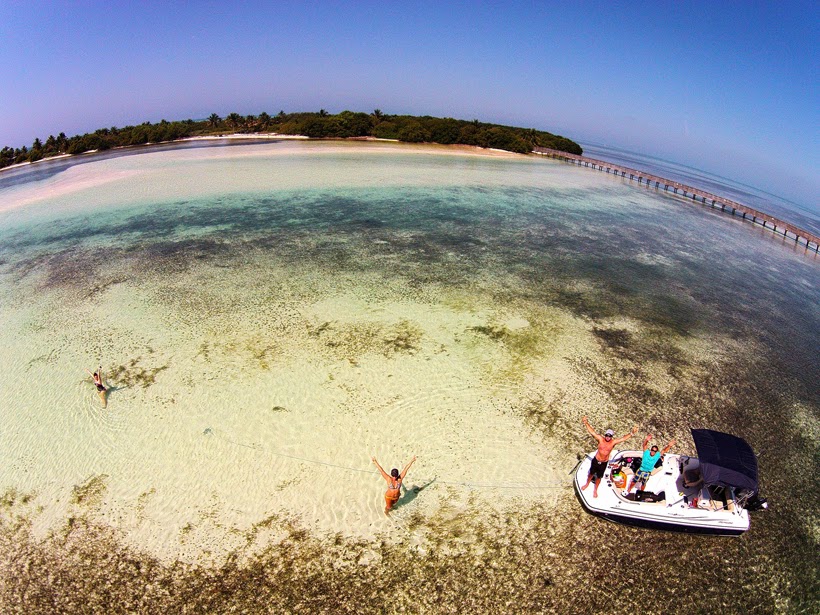 |
| Artist Letty Nowak and friends enjoy a beautiful day in Key West, Florida. |
“You never know who you’re going to meet,” says artist Letty Nowak of why she loves her home on the tiny island of Key West, Florida. From bumping into Florida celebrity Jimmy Buffett to being introduced to her art dealer in New York,Letty says the tight-knit community just shy of five miles long is a melting pot for...]]>
 |
Artist Letty Nowak and friends enjoy a beautiful day in Key West, Florida. |
“You never know who you’re going to meet,” says artist Letty Nowak of why she loves her home on the tiny island of Key West, Florida. From bumping into Florida celebrity Jimmy Buffett to being introduced to her art dealer in New York, Letty says the tight-knit community just shy of five miles long is a melting pot for international movers and shakers that seasonally return to the island’s crystal blue waters to relax.
 |
The scene on the main thoroughfare, Duval Street in Key West. |
 |
On the street by Fury Surf Shack. |
The colorful characters of Key West were an early inspiration in Letty’s painting career. Straight out of art school in Michigan and moving to Key West, she embarked on a series of paintings over the course of five years titled “Faces of Key West” that encompassed 100 different portraits of local people. Her next series in progress, “Faces of Surfing” adapts that same concept to surf community personalities. “My Dad owned surf shops in Michigan [where I grew up] so it is pretty special for me to bring that industry into my painting career,” says Letty.
 |
Left, portrait of surfers Debbie Beacham and right, Maya Gabeira painted by Letty Nowak. |
 |
Letty with her paintings. |
On top of her painting career and managing her own art gallery, The Lemonade Stand Gallery in Key West, Letty also co-owns three Fury Surf Shack stores and the recently opened lifestyle boutique called Key West Sunshine Club (where Seea is sold).
Seea caught up with Letty between her nonstop travel schedule (she has an art studio in La Jolla, Calif. and is frequently traveling for fun) to get the inside scoop on the hidden gems of Key West, her journey as an artist and bringing California designers to the Florida Keys.
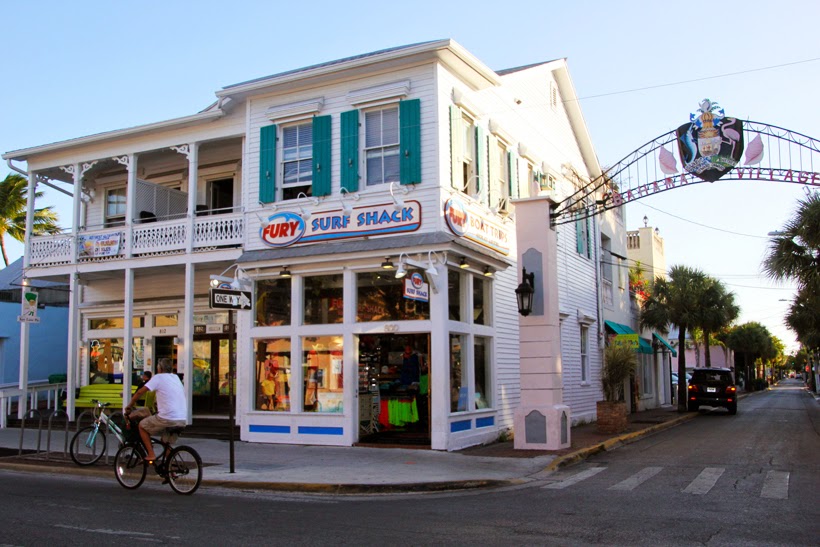 |
One of the Fury Surf Shacks that Letty co-owns. |
Why do you love living in Key West?
Key West is its own little place. It’s a three and a half hour drive to Miami and it’s 90 miles from Cuba. People from all over the world — artists, business people, people who spend time between Key West and NYC — everyone lives in the same neighborhood together.
What is Fury Surf Shack in Key West and the new Key West Sunshine Club where Seea is sold?
The Fury Surf Shacks are three surf shops I co-own with Marius Venter in Key West, Florida. They have been open now for seven years. We stock the big core surf brands.
Key West Sunshine Club is a brand new boutique we just opened that is surf-inspired, but really select in brands that I have discovered through living in California. I had to introduce them to the Key West/South Florida market. I wanted them set apart and in their own space.
 |
View from the outside of the Key West Sunshine Club at night. |
 |
Inside the Key West Sunshine Club. |
What is the women's surf scene like in Florida?
North of Miami, it is definitely prominent. I recently surfed with Frieda Zamba who was an amazing athlete. South of Miami and into the Keys, it is more of a SUP scene. It’s surrounded by reef, so no waves. When the water’s really still, its Caribbean blue. There’s lots of manatee, dolphin and wildlife.
Where do you usually surf?
I'm lucky enough to be surrounded by waves in San Diego when I'm there so you can normally find me anywhere between Grandview and Mission Beach.
What kind of support do you encounter from other women in the surf community?
I have recently started having great conversations with Coco Tihanyi who owns Surf Diva in La Jolla with her sister Izzy. It's been great to compare notes and ideas with her. Florencia Gomez of Greenpacha and I have tossed a lot of great ideas around about art, business, and the surf industry. Lisa Anderson just said yes to being painted. Lyndie Irons of Acacia has also been a subject of mine and an inspiration.
What were the keys to your success as a co-owner of Fury Surf Shack stores?
First, to have fun. I also had to learn to share the reigns, not only with my business partner, Marius who is male, but also with my staff. I was open to try their new ideas and we were able to create successful shops. I also had to learn to keep a good balance of merchandise with everything from quantity, sizing, color palettes, and when to push the limits of style.
Marius’s parents had surf shops while he was growing up in South Africa and my parents had surf shops in Michigan so it is pretty cool to share some of our own now.
What special touches did you offer to the business as a woman?
I have been able to make the interior of our spaces almost totally custom with a look that is held over into each of our shops. Custom racks, tables, and counters are built along with found re-finished furniture. Most of the little bowls and baskets, which hold our jewelry and accessories, have been brought from my travels or made from my artist friends. It is the personal touches that I think customers appreciate in our type of stores. I learned this from my Dad and wish I could do it as good as he could. We have really gone all out in our shops, as they are an extension of a lifestyle we love.
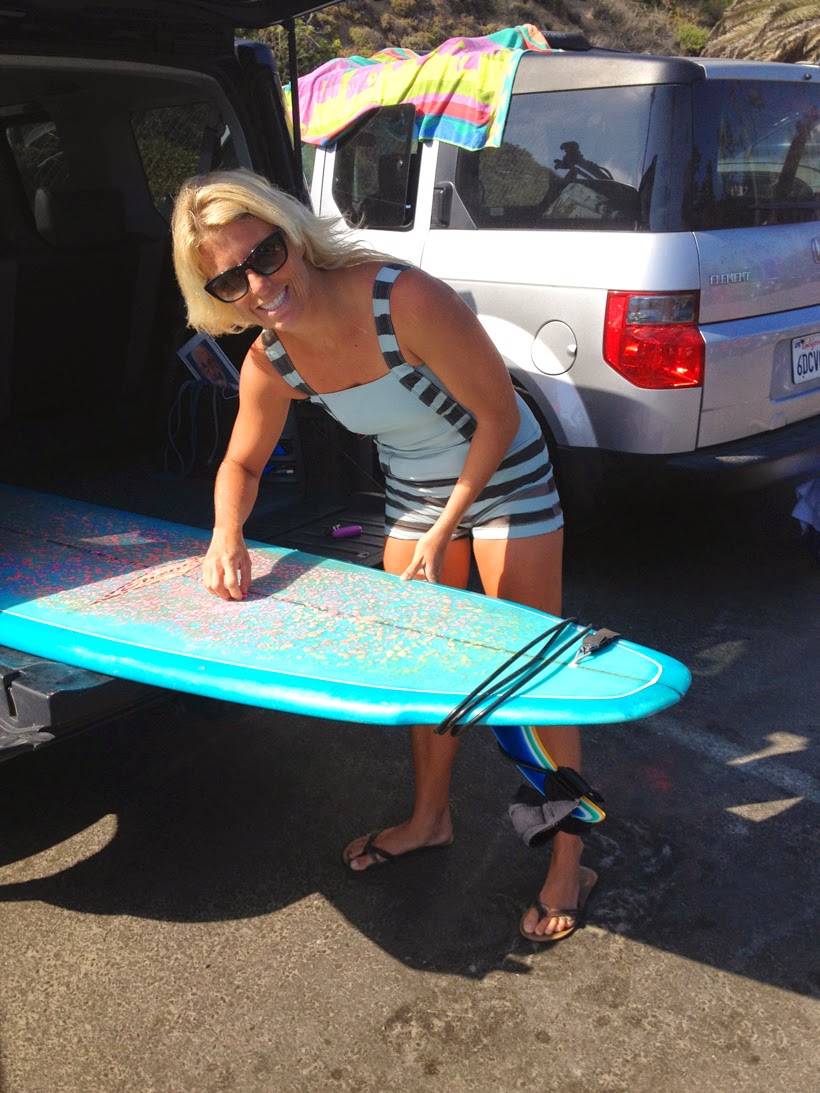 |
Letty in the original Malibu! |
 |
Letty painting in the studio. |
How did you get into painting?
I started painting because I knew I had a strong attachment to my art and my grandfather told me to go for it as I had nothing to lose coming out of university. It was great advice.
How did you find your voice in painting portraits?
We had to choose one style/subject for an entire semester at university. At the time, portraits seemed like the hardest thing to learn so I chose them to have help from my professor who, funnily enough, ended up being an abstract painter. I found my voice for portraits after the first one I finished. I have never looked back since that class. There was something about the challenge of taking something so personal and recognizable and then making have it's own life as a 2D painted object.
You’ve painted a lot of important people in the surf community for your “Faces of Surfing” series. How did you come to be able to paint these personalities?
It started in Tavarua, Fiji. My boyfriend took me there for my 30th birthday. There, I met Richard Woolcott [co-founder of Volcom] photographed him, painted him, and showed his painting in New York City, which was secretly the start to the Faces of Surfing. On my next trip to Tavarua, I met Bob Hurley [founder of Hurley]. I was telling him about my work and he offered me an exhibit at Hurley's headquarters. The community support has been really unbelievable.
What do you try to capture about a person's personality when painting a portrait?
There is not a lot of expression I am looking for — just pretty frontal and honest. If I do it right, their personality will come through as I paint them through my marks and colors, leaving lines soft or hard, with the light that is reflecting on them.
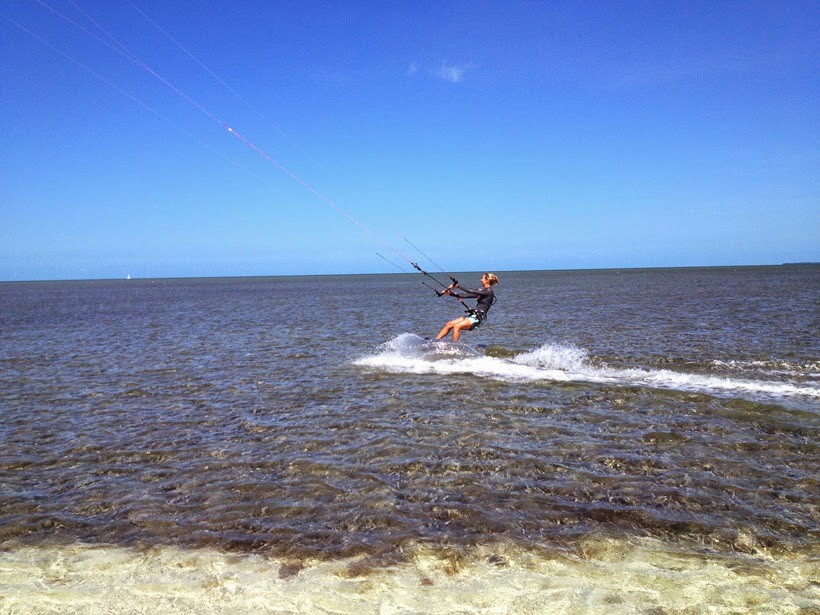 |
The Florida Keys are an easy place to try kite boarding. |
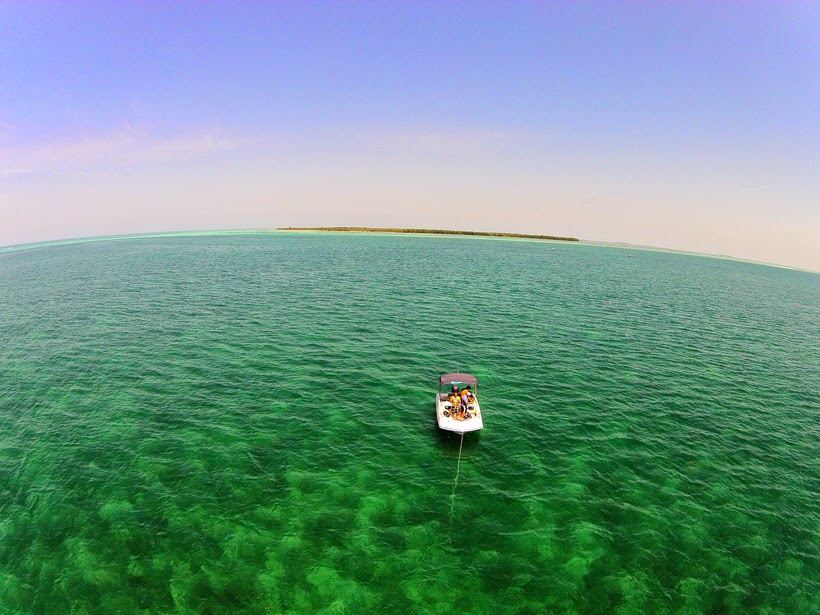 |
Or just enjoy the waterfront view. |
What attractions would you suggest to visitor coming to Key West?
[Outdoors there’s] diving, snorkeling, SUP, fishing. Take kiteboarding lessons. You’re just learning to kite board in waist deep water. Put on a mask and snorkel and check out the fish in Fort Zachary Taylor State Park forest.
Go to some art openings. The studios of Key West bring resident musicians and have gallery openings. It can really change your experience in Key West.
Get coffee at the Cuban Coffee Queen, which I painted a big mural on. For breakfast/lunch/dinner, Blue Heaven. You sit outside amongst roosters just running around. There’s a band and they have their own bakery on premises. It’s in the same area as Sunshine Club, one of the last old parts of Key West with families that have lived there forever. Seven Fish is a little restaurant only open for dinner that’s hard to get into because its super small but its in an old town neighborhood. Finding all the hidden gems off the beaten path is one of the cool parts about Key West.
 |
Fort Zachary Taylor State Park. |
What kind of advice do you have for women who want to make a living as an artist?
"ABL," Always Be Learning. That is what I told myself from my first days out of college. Nurture your style, push your limits, and realize the possibilities are endless. Be confident and persistent. Work towards your goal. If you believe in yourself, it will happen.
To read about more inspiring women surf shop owners, check out stories on:
]]>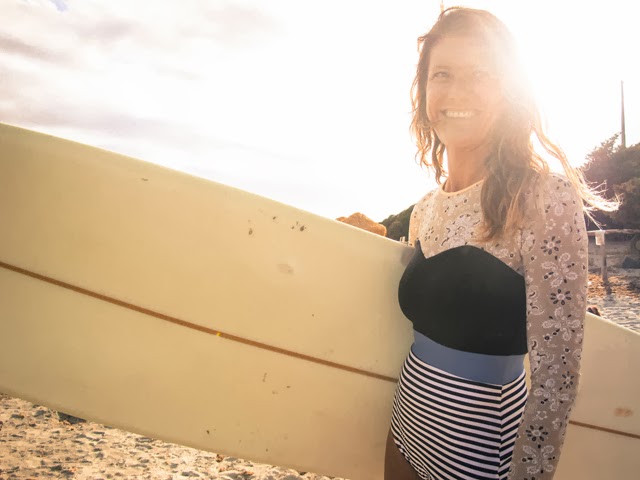
Natalia’s wanderlust lifestyle is even truer now that her...]]>

Natalia with her longboard. Photo by Filippo Maffei.
For as long as we have known our dear friend, surfer, fashion illustrator and Seeababe Natalia Resmini, she is always traveling. From her hometown in Italy, to chasing the swells to Morocco, France and Spain, her life is full of adventure hanging out with stylish surfers around the world.
Natalia’s wanderlust lifestyle is even truer now that her newest home—a boat in Sardinia, Italy—is frequently in motion, gliding through water. From her “office” on the boat or wherever she can find a place to paint, she makes illustrations for the Italian newspaper, Corriere della Sera and Elle Italy. Look out for Natalia in "Peninsula, a film by Onde Nostre" coming out next spring that documents the history of the Italian surf scene shot completely on 35mm, 16mm and super8 film.
It's been a while since we last surfed with Natalia in Italy while filming "Girls, Girls, Girls, a film by Onde Nostre" so we thought it was time to catch up with her again and hear what it’s like to live on a boat.
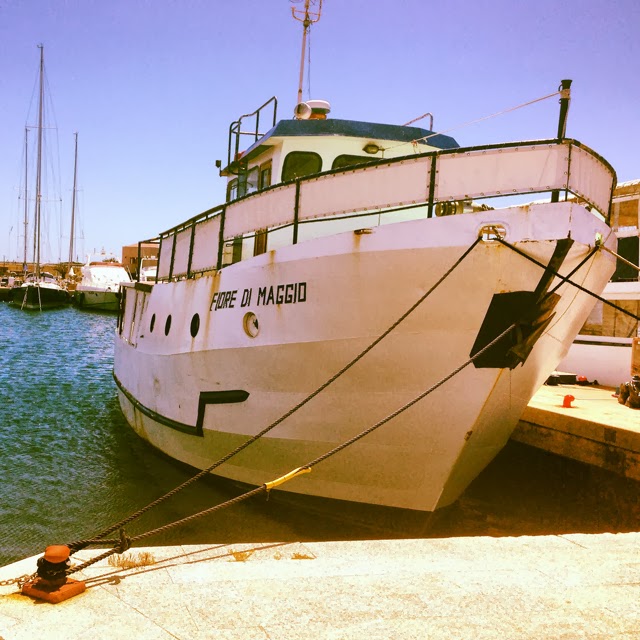 |
Natalia's home, "Fiore di Maggio." |
When did you start surfing?
I've start surfing during a trip in Hawaii, around 1998. I was just a "big girl," my parents allowed me to go there and I was super stoked. I remember myself dreaming with this airplane ticket in my hands,"Milano-Honolulu."I just couldn't believe it. I've learned pretty much watching the others and just go. The main ingredient? Determination, on and on. Back to Italy, I've never stopped even if it was not an easy road. The Mediterranean Sea does not have consistent waves. At that time I also started my art studies. I began playing with "the elements," studying shapes on paper and new forms on my board.
 |
Life on the sea. Photo by Filippo Maffei. |
What do you love about living on a boat and that every day is different?
I love so much to wake up in the harbor. I'm such a dreamer and my spirit gets big nourishment every morning. My boyfriend is a sailor, a surfer and a fisherman, he's such a great waterman. Everyday is a small adventure. We live in South Sardinia, and it’s always warm and sunny. The boat is old school, very comfortable, and there is a lot of space for chilling and creating. My main activities are: surfing, painting, swimming, reading, thinking, and fishing. The worst thing that could happen to me would be go back living in a normal house!
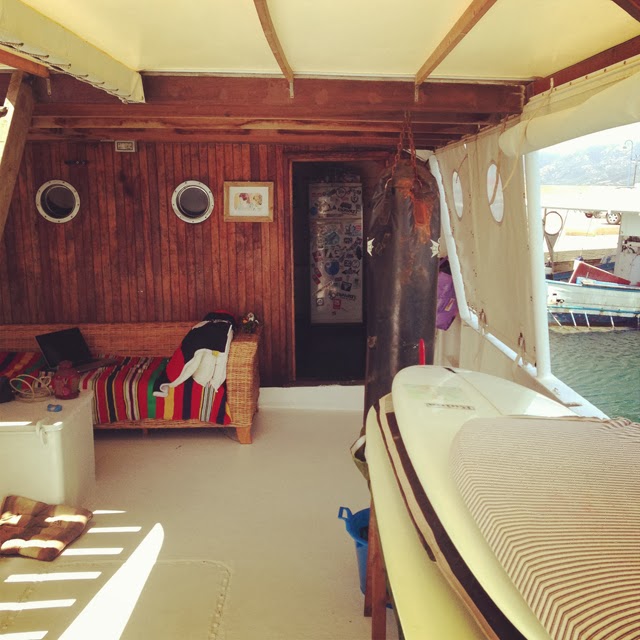 |
Natalia's office in the boat. |
Where are some of the favorite places you have traveled to that are inspiring for your art?
Morocco is one of my fav places—close to Italy, cheap flights. In the few last years I've been there so many times! It has a magic vibe. There is a sort of "light Islamic" culture which is interesting to discover. Essaouira is one of the best cities I've seen in my life. The architecture is very ancient and sophisticated. Brazil is also very inspiring. I loved the perfect mix of relaxed atmosphere, samba and healthy lifestyle. Fruits are so tasty over there! Impossible not to mention Basque country, the European surfing mecca, with so many interesting people to meet.
What do you always pack with you when you travel?
Sunscreen 50+, white papers and watercolors, my "fatima hands" necklace (it brings a good luck while traveling), some book and a black Balenciaga Bag.
 |
Illustration by Natalia Resmini |
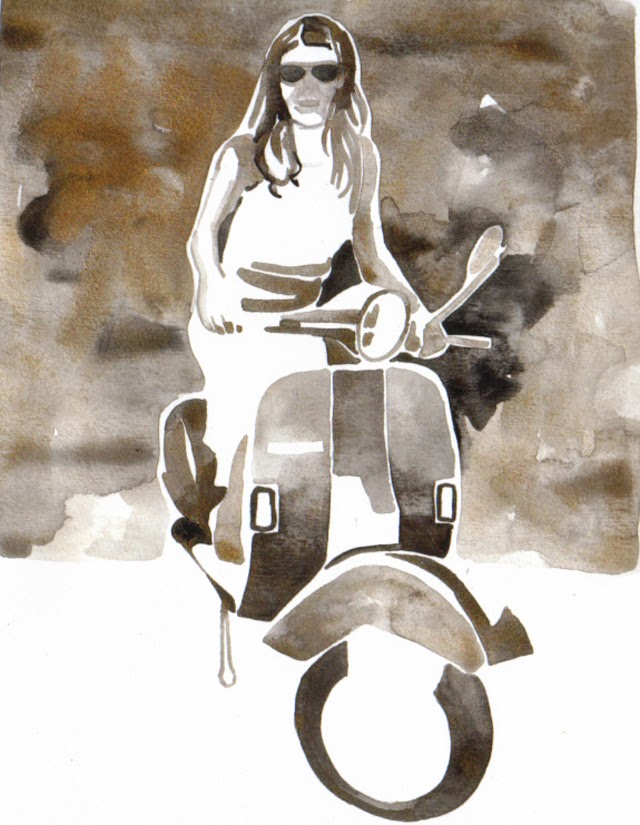 |
Illustration by Natalia Resmini. |
Why is it important to have good surfing girl friends?
Me and my girlfriends we support each other—this is the main thing. We share beauty tips and laugh. They are all very ironic, I admit. When the line-up becomes "pink" its always a great fun. Especially if the crew is wearing Seea! I love Amanda because she spread the Italian glamour in the world. She is always positive and she works like crazy, but never complains. She is not just a surfer sista: she is a strong and determinate businesswoman, always a good example for me.
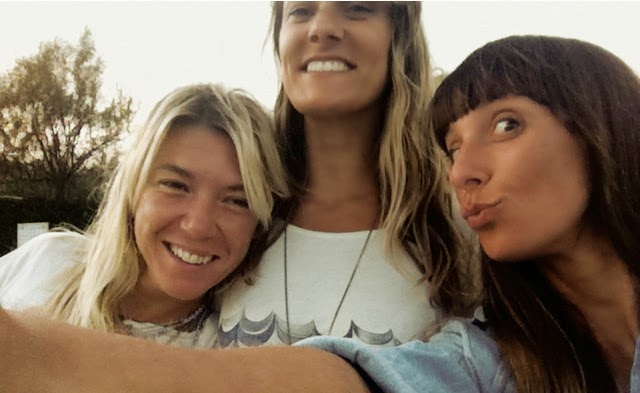 |
Elisabetta Del Ballo, Natalia Resmini and Amanda Chinchelli in Italy filming with Onde Nostre. |
Why do you love about being apart of the surfer community and that we are all connected around the world?
It's a great question. I've met a lot talented people around the world. I can say that all the surfers are creative and very idealistic. Beside the hippie allure, which is the first impression, I noticed a true consciousness towards the "real problems." With my surfer friends we often speak about pollution, health, religion. Instead, the people that I've met in the fashion business are quite unaware. I believe the surfing community is a kind of big family! Longboarders in particular are peaceful and laid-back. There is a big link among all of us. Internet helps a lot.
 |
Natalia in Morocco. Photo by Mohamed Rob. |
 |
Natalia in the Onde Nostre film, "Girls, Girls, Girls." |
What projects are you working on now?
At the moment I'm painting a lot on t-shirts. My capsule collection is called "fishing for religion." It's handmade in Italy with love! They are all unique pieces: I design the graphics, I use a lot of pastels and sometime I add some golden pigment as well. The result is very different! I've started to sell them in some selected shop. My favorite is Swell Surf Shop and Cafè in Sinnai, (Sardegna Island) they sell a lot of different brands.
 |
Fishing for Religion t-shirt. |
What other advice do you have to share?
My philosophy at the moment is quite simple:
1) Don't compare yourself with the others people go straight for your road.
2) Try to be grateful and smile.
 |
Basking in the sun. |
Thank you Natalia for spreading the Seea love in Europe and your friendship!
See more of Natalia's work on her website, blog and Instagram.
 |
Ode to Seea styles. Illustrations by Natalia Resmini. |

One thing that we love about seeing customers wear Seea is all the different ways that they make the suits their own. We were touched to hear from Santa Cruz photographer Nikki Brooks that she was inspired by the beauty of the suits to create an underwater photo series of Seea Mermaids in the chilly waters of...]]>

One thing that we love about seeing customers wear Seea is all the different ways that they make the suits their own. We were touched to hear from Santa Cruz photographer Nikki Brooks that she was inspired by the beauty of the suits to create an underwater photo series of Seea Mermaids in the chilly waters of Monterey Bay.
Nikki wanted to create a proper sub-marine presentation for the swimming ladies, so she constructed “portholes” to put them in, which were made from salvaged appliances and nautical memorabilia from Jack O'Neill's “Marie Celine" schooner. Yes, the very same Jack O’Neill that invented the wetsuit!
As a born and raised Santa Cruz native, Nikki has photographed the local surf culture for Surfline.com and traveled to document events like the Vans Joel Tudor Duct Tape Invitational. We asked her more about her brave photography subjects and what she loves about surfing in Santa Cruz.
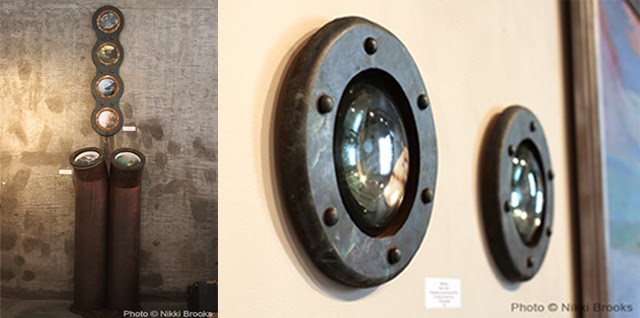 |
| How Nikki’s photographs were displayed at the Robert Blitzer Gallery in Santa Cruz for the "Oceans of Art" exhibit, curated by Shawn "Barney" Barron. |
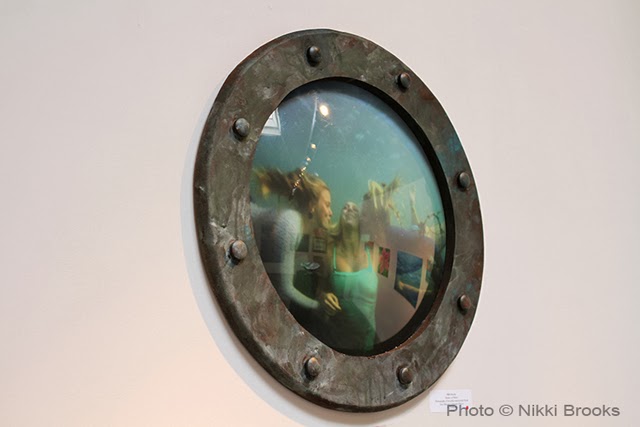 |
Where did you get the idea to photograph your friends underwater?
It all started with the Seea suits, for reals! I loved the style and was inspired to do something creative with the suits besides lifestyle or glam photos. I figured I would do the unnatural thing and take underwater photos of my surfing friends swimming in the ocean. Usually one sees underwater photos of surfers duck diving or swimming in clear, coral laden, warm, tropical waters. Here in Santa Cruz and across the Bay, the water is cold year around, full of nutrients, resulting in murky green water, full of life and strewn with kelp forests. I sought out my friends that could bare the cold to venture into the water donning Seea suits.
What was the inspiration for putting the photographs in salvaged marine parts?
I wanted to create a visual means to see what I was seeing underwater, a moment encapsulated in time, but something you can always look at and feel like it is happening right this moment… The treasures on loan from Jack O'Neill's schooner and the O'Neill Sea Odyssey were on display for the exhibit at Robert Blitzer Gallery only, not to be sold. My dad, Denny Dederick, helped create the weathered nautical fixtures and portholes with his crafty patina work, resulting in something salvaged and from the past, but with a twist.
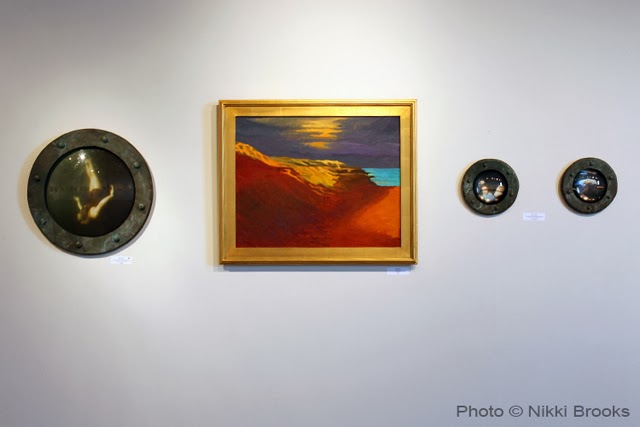 |
| Nikki's photography display for the group art show at the Robert Blitzer gallery. |
What kinds of people, places and things do you like to photograph for fun?
People I love to photograph are my own children, my friends, people I admire or honor, people that interest me or inspire me. Places I photograph have often been nature oriented.
I am drawn to the adventure or challenge that is involved in order to get the shot. Whether it is scrambling to get on a ski at a big wave spot, hiking along the Lost Coast, or swimming into the lineup, for me photographing my subject means I am involved or partaking in the experience as well. Other times it is just really cool to be in the same frame of mind and connect myself to the person I am working with, and really be on their level, so in a way, I am working to capture a moment that truly represents them.
 |
As a female surfer, it was natural for me to gravitate to my own female kind as my photography subjects. To document grace and beauty and style in surfing is something I really appreciate and I am drawn to. And I also wanted to document the women's surf movement, and it has been such an amazing adventure and I have met so many talented surfers and friends in the process. I really wanted to showcase females as athletes, maybe they look like they are dancing on a wave, maybe they are powerful, maybe they are just charging. And there was and is so much fun in the process, the lifestyle, the laughs, the travels, the adventures. Beauty is a part of it all.
Surfing was not only about the one shot of a girl's butt cheek, doing a bottom turn. There is such natural beauty in surfing, and I just wanted to document it in its true form. However, it is both female and male surfers that I enjoy photographing, riding crafts short and long, on waves big and small.
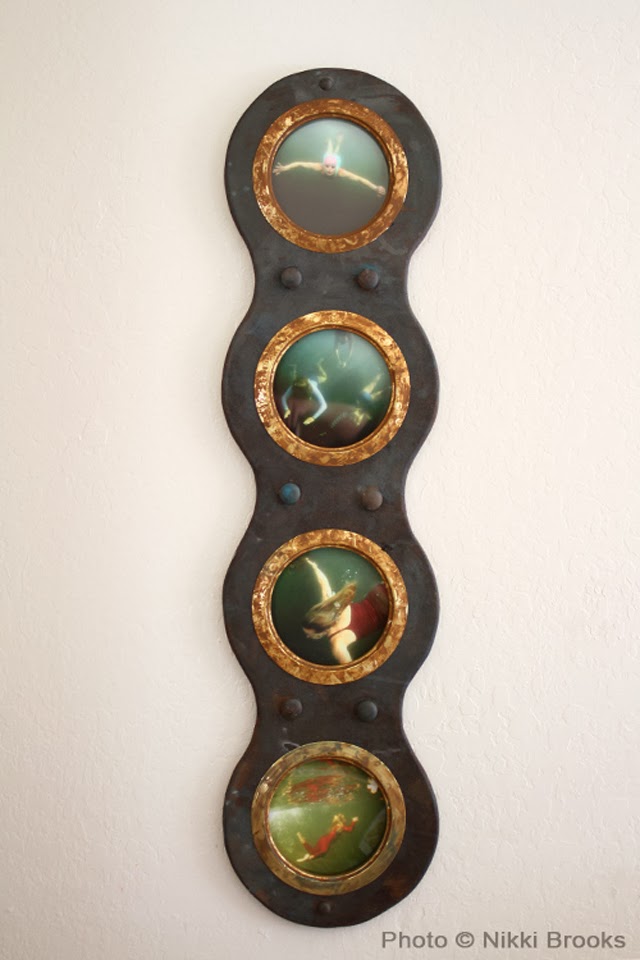 |
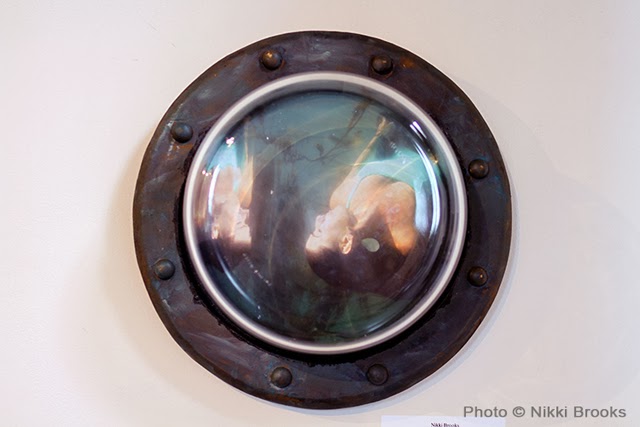 |
The women's surf community in Santa Cruz is diverse and rich, filled with living legends (Jane the Lane, Rosemary Rice, Kim Mayer), astounding big waves surfers (Savannah Shaughnessy, JamStar, Sarah Gerhardt), craftswomen and stylish surfers such as Ashley Lloyd Thompson, strong community leaders (Zeuf Hesson), and up and coming groms.
The surfing community as a whole is full of many characters, both male and female, and all energies are vibrant in the water and create a family. The surfing community here is one whose respect should be earned, like all solid surf communities. Once earned, there is a strong bond and we are all connected, here in this northern nook of the Monterey Bay, and around the world.
It really is something, no matter where you are in the world, the ocean bonds us all together, and no one realizes this more than surfers.
Thank you Nikki for sharing your art and we are happy to be connected to you too through your creativity and our mutual love of the ocean!
]]>
One of the...]]>
One of the pioneers of online surf forecasting, Wetsand recently went back to their roots with the relaunch of their original forecast site, now under wsurf.com. The site features a free long range surf report, along with an amazing gallery of video, images, and art, including these lovely works from Wetsand's own Shannon Menzel.
]]>
Created by master illustrator Simone Massoni, the Seea Lady exemplifies Simone's comic, cartoon-like style, and his penchant for distressed, colorful prints. Originally a creator of children's books, it's easy to see the magic in Simone's whimsical images and storybook design.
With the manifesto "Original, push the visual", Simone has explored illustration, photography, art, graphic design, and music for a large list of international clients. Intent on "defending and spreading passion" for everything visually stimulating, Simone has created an impressive body of work, including recent projects for Nokia, Guess Kids, & Wired Magazine.
Instrumental in creating a visual voice for our brand identity, we are forever grateful to Simone for bringing the Seea Lady to life, and we look forward to seeing whatever comes next!!
Moral of the story: Don't be afraid to look Simone up, if you every need to "Sketch This Out"!
]]>"The panic to be original is one of the evidences of a lack of knowledge"
self-conscious about the use of materials.
What is tin is tin.


